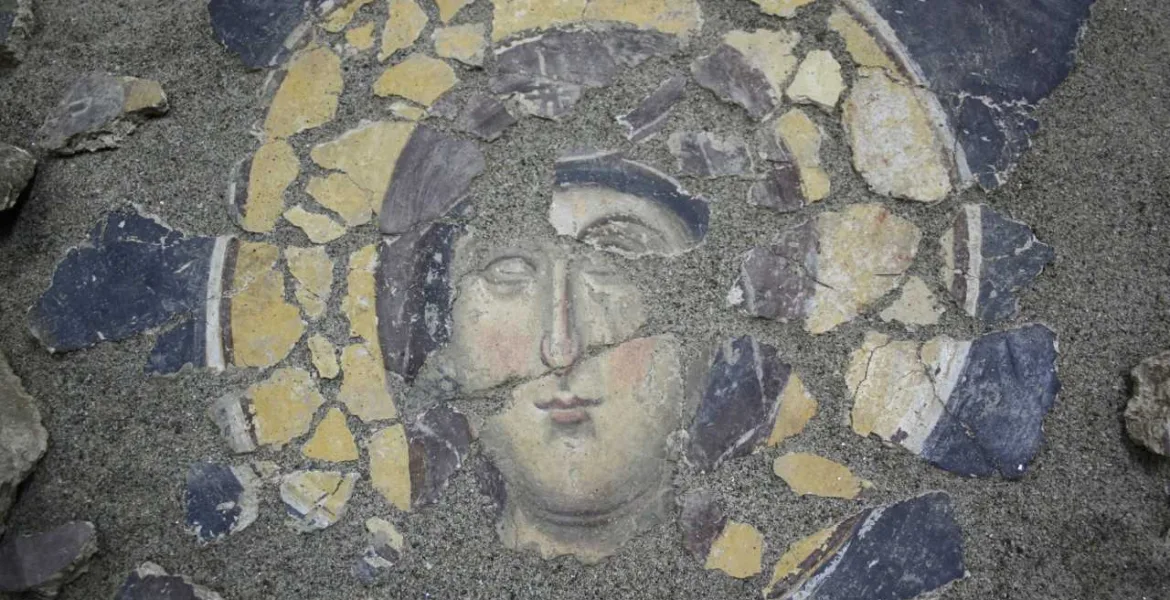The Acropolis of Thessaloniki, from its ancient establishment, was the strongest and most important fortress of the city. It played a crucial role throughout its history, especially during the late Byzantine period, not just as a simple neighborhood, but as the "divinely fortified tower" with magnificent sacred temples where the Archbishop officiated, and as the ultimate refuge of the rulers, as the written sources suggest.
Just a few meters north of the exit gate of the Acropolis, in close proximity to the crucial point where the city's intermediate wall meets the western segment of the Acropolis wall, and near the strong towers with imperial inscriptions, an unknown temple from the Paleologian era was revealed in a rescue excavation on Stergiou Polydorou Street No. 5. The temple has a dense cemetery from the same period.
Specifically, approximately half of the polygonal-shaped Holy Bema was revealed, estimated to be pentagonal, with two construction phases. The wall of the Bema is built with stones and bricks, many of which are sealed with crosses. It has a careless brick-bonding construction system and the soil is used as a connecting material. In a very short distance from the painted wall of the Bema, the Holy Altar was revealed. The altar is built and has a solid cubic shape.
From the construction characteristics of the upper structure of the Holy Bema, its iconographic decoration, and its movable equipment, the excavation revealed valuable elements. Between the wall of the Bema and the Holy Altar, a cross-shaped pebble vessel was uncovered, which represented the inaugural of the second construction phase. Both on the surface of the curved wall and on the Bema, well-preserved fragments of the iconographic decoration were found. The lower part of the representation of Christ's Humiliation was preserved from the decoration of the Bema. From the decoration of the sacred arch, a fragmentary representation of the Nativity was preserved. Many fragments of luxurious frescoes from the space of the sanctuary were found within the destruction layer of the Bema. These fragments include several pieces that are gilded. From these fragments, it was possible to partially reconstruct the image of the Platytéra of Theotokos, which undoubtedly adorned the upper zone of the Bema. The fresco of the Platytéra at the Temple of Polydorou is a masterpiece of the second decade of the 14th century (1310-1320) and artistically belongs to the high Paleologian art of Thessaloniki, similar to the depictions in the temple of Agios Panteleimon, of the 13th-14th century, and of Nikolaos Orfanos (1310-1320).
The chronological indications resulting from the excavation data of the temple are reinforced by the corresponding findings from the investigation of the cemetery, which developed to the north and east of the multifaceted Bema and within the interior of the northern rectangular apartment, but not within the sanctuary. These are simple yet carefully arranged burials, placed on natural ground, of the residents of the Byzantine Acropolis. This dense cemetery provides particularly valuable information, not only because it completes the image of the temple to which it belongs, but also because so far, no find of a similar extent has been found within the Acropolis, an area for which our information remains limited.
Within the excavation area, 57 burials were investigated in successive layers. These include infant, child, and adult burials, as well as reburials, which took place in tombs of various types: ark-shaped, tile-covered, free pit graves, either plain or covered with horizontally laid slabs of decreasing width. Two particularly large-bodied male burials, with a height reaching two meters, and the burial of a pregnant woman, which contained skeletal remains and the fetus's skull in a delivery position, are of particular interest.
Based on the overall excavation picture, as well as the numismatic evidence from closed sets of burials and the building that included Latin imitations and cuts of Michael VIII Palaiologos (1261-1281), it can be formulated that the cemetery and the temple with the polygonal Bema were established after the middle of the 13th century. This original construction underwent a second phase of construction in the early 14th century, specifically around the twenty-year period of 1310-1330. The temple in its second phase did not have a long life as coins (copper coins depicting the Patron Saint of the city and Tornesius of Manuel II Palaiologos, 1391-1423/25) and ceramics reveal the radical destruction and abandonment of the temple in the late 14th century and early 15th century. After this time period, evidence is scarce, and it appears that the temple remains buried without any other evidence of its use until the early 20th century.
The dating of the temple places it in the turbulent period of the history of Thessaloniki immediately after the Latin conquest. This period is characterized by dynastic conflicts, zealous movements with acts of violence that took place within the city walls, the residence and crowning of kings in the city itself, until its final submission and subjugation to the Ottomans.


